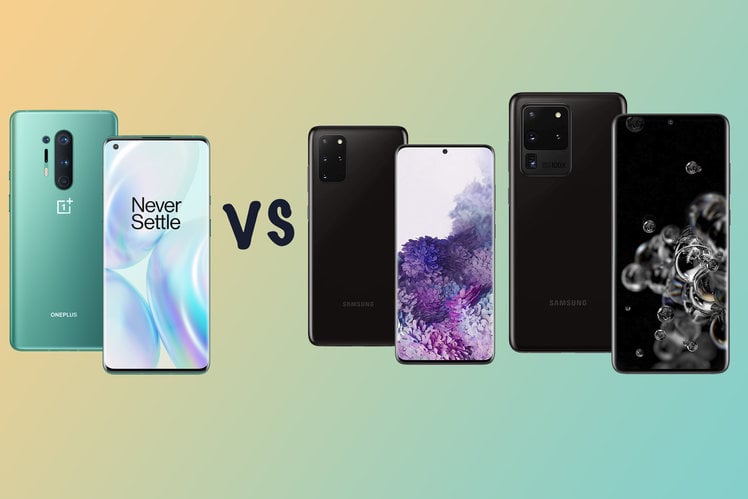
OnePlus revealed the OnePlus 8 Pro and OnePlus 8 in the middle of April, offering flagship specifications and premium designs at cheaper prices than the likes of Samsung’s Galaxy S20 range.
How does the OnePlus 8 Pro compare to Samsung’s top-of-the-range Galaxy S20 Ultra and Galaxy S20+ though? Here are the specifications up against each other.
Design
- OnePlus 8 Pro: 165.3 x 74.4 x 8.5mm, 199g
- Samsung S20+: 161.9 x 73.7 x 7.8mm, 186g
- Samsung S20 Ultra: 166.9 x 76 x 8.8mm, 220g
The OnePlus 8 Pro, Samsung Galaxy S20+ and Samsung Galaxy S20 Ultra all offer premium designs with metal cores and glass rears, though OnePlus offers matte options, while Samsung offers gloss only.
The Samsung S20+ and S20 Ultra both have punch hole cameras centralised at the top of their displays, while the OnePlus 8 Pro has a punch hole camera positioned in the top left corner of its display.
On the back, the OnePlus 8 Pro has a slightly neater design with a pill-shaped vertical camera housing positioned in the middle, while the Samsung Galaxy S20+ and S20 Ultra both have more prominent rectangular camera housings in the top left corner of their rears.
All devices being compared here offer IP68 water and dust resistance and they all have in-display fingerprint sensors.
In terms of size and weight, the OnePlus 8 Pro sits in the middle of the Samsung Galaxy S20+ and S20 Ultra.
Display
- OnePlus 8 Pro: 6.78-inch, Quad HD+, 120Hz
- Samsung S20+: 6.7-inch, Quad HD+, 120Hz
- Samsung S20 Ultra: 6.9-inch, Quad HD+, 120Hz
The OnePlus 8 Pro has a 6.78-inch display with a Quad HD+ resolution offering a pixel density of 513ppi. It offers an aspect ratio of 19.8:9 and a refresh rate of 120Hz.
The Samsung Galaxy S20+ has a 6.7-inch display with a Quad HD+ resolution and 525ppi, putting it at a similar size to the OnePlus 8 Pro, while the Ultra is larger at 6.9-inches. It too has a Quad HD+ resolution though, with a pixel density of 511ppi.
Both Samsung devices have a 120Hz refresh rate like the OnePlus 8 Pro, though you only get this faster refresh rate at Full HD+ resolution rather than Quad HD+. They both have a 20:9 aspect ratio display.
All devices being compared in this feature have a AMOLED panel and offer HDR10+ support.
Cameras
- OnePlus 8 Pro: 48MP main, 8MP telephoto, 48MP ultra wide, 5MP colour filter
- Samsung S20+: 12MP main, 64MP telephoto, 12MP ultra wide, DepthVision
- Samsung S20 Ultra: 108MP main, 48MP telephoto, 12MP ultra wide, DepthVision
The camera department is perhaps the area these devices differ the most.
The OnePlus 8 Pro has a quad rear camera, made up of a 48-megapixel main sensor, 8-megapixel telephoto sensor, 48-megapixel ultra-wide angle sensor and a 5-megapixel colour filter sensor. There’s a dual LED flash and a range of features including Video HDR, Smart Pet Capture mode and 3x hybrid zoom.
The Samsung Galaxy S20+ has a quad rear camera too, made up of a 12-megapixel main sensor, 64-megapixel telephoto sensor, 12-megapixel ultra wide sensor and a Depth Vision time of flight sensor.
The Samsung Galaxy S20 Ultra meanwhile, has a 108-megapixel main sensor, 48-megapixel telephoto sensor, which is a 10x hybrid optic periscope lens, 12-megapixel ultra wide sensor and a DepthVision sensor.
All three devices will perform differently, with strengths in different areas. Read our in-depth reviews of each device for a breakdown of the camera capabilities of each.
Hardware and specifications
- OnePlus 8 Pro: Qualcomm SD865, 8/12GB RAM, 128/256GB storage, 4510mAh battery
- Samsung S20+: Qualcomm SD865/Exynos 990, 12GB RAM, 128/256/512GB storage, 4500mAh battery
- Samsung S20 Ultra: Qualcomm SD865/Exynos 990, 12/16GB RAM, 128/256/512GB storage, 5000mAh battery
The OnePlus 8 Pro runs on the latest Qualcomm Snapdragon 865 processor with a choice of 8GB of RAM and 128GB of storage or 12GB of RAM and 256GB of storage. There is no microSD support for further storage expansion.
The Samsung Galaxy S20+ and S20 Ultra both run on either the Exynos 990 or Qualcomm Snapdragon 865 processor, depending on the region. Both have 12GB of RAM as standard but the Ultra also comes in a 16GB option. There are various storage options, with 128GB, 256GB and 512GB models available, all of which offer microSD storage expansion up to 1TB.
In terms of battery capacities, the OnePlus 8 Pro has a 4510mAh battery, the Samsung Galaxy S20+ has a 4500mAh battery and the Samsung Galaxy S20 Ultra has a 5000mAh battery. All three devices off fast charging and wireless charging, but the Samsung devices also offer reverse wireless charging.
All three devices being compared here are 5G enabled.
Conclusion
The OnePlus 8 Pro sits in the middle of both the Samsung Galaxy S20+ and the Samsung Galaxy S20 Ultra but it is quite a bit cheaper than both models, coming in around the same price as the standard Galaxy S20 instead.
There’s plenty of similarities between the three devices too, despite the price difference. All have large displays, premium designs, powerful hardware and good software experiences, albeit different.
You get microSD support on the Samsung devices, along with reverse wireless charging capabilities and some interesting camera functionality, especially on the S20 Ultra, but you pay more for these attributes – a lot more in the case of the Ultra – so the decision between these handsets will come down to your budget and what features matter to you most.
